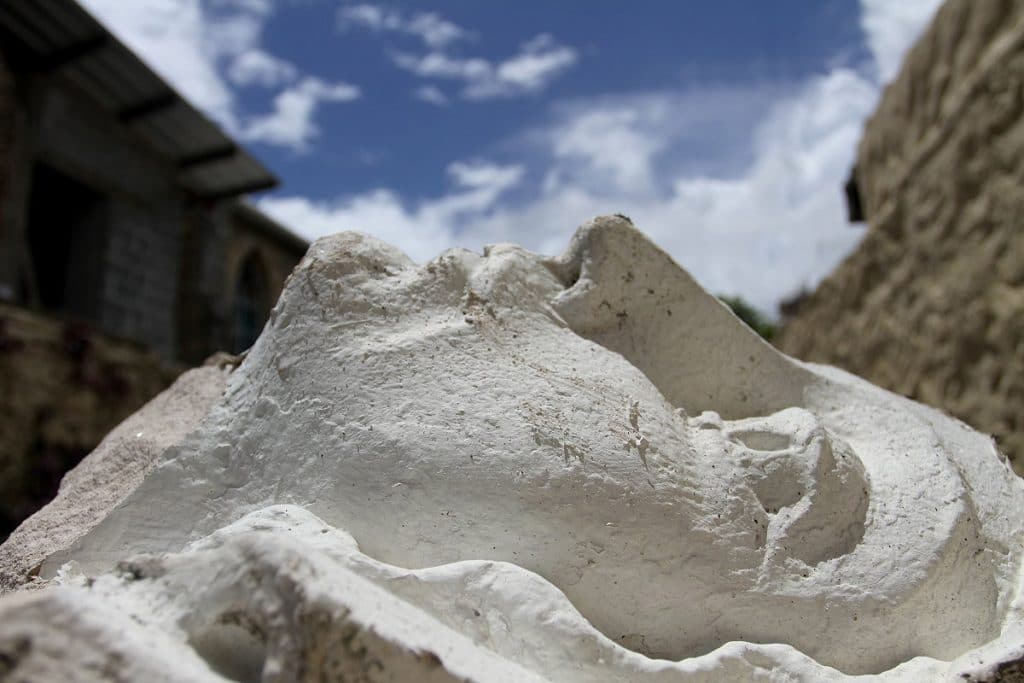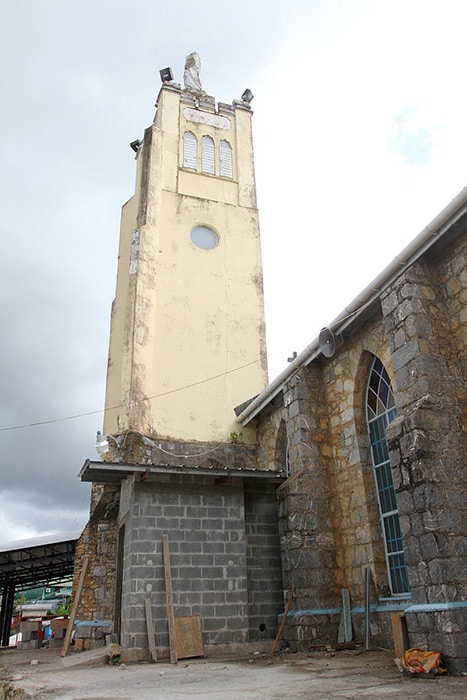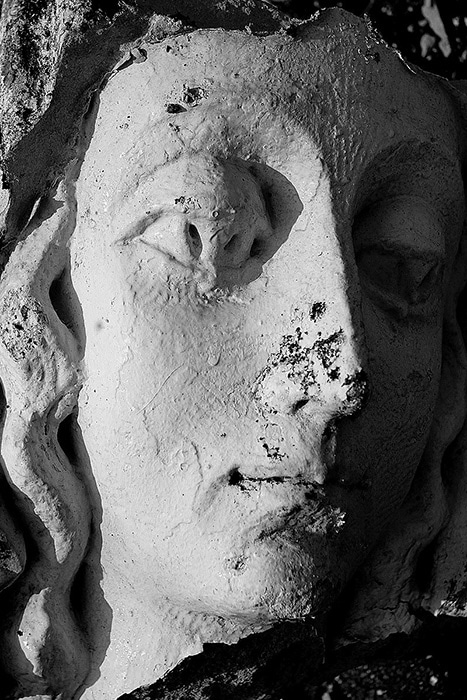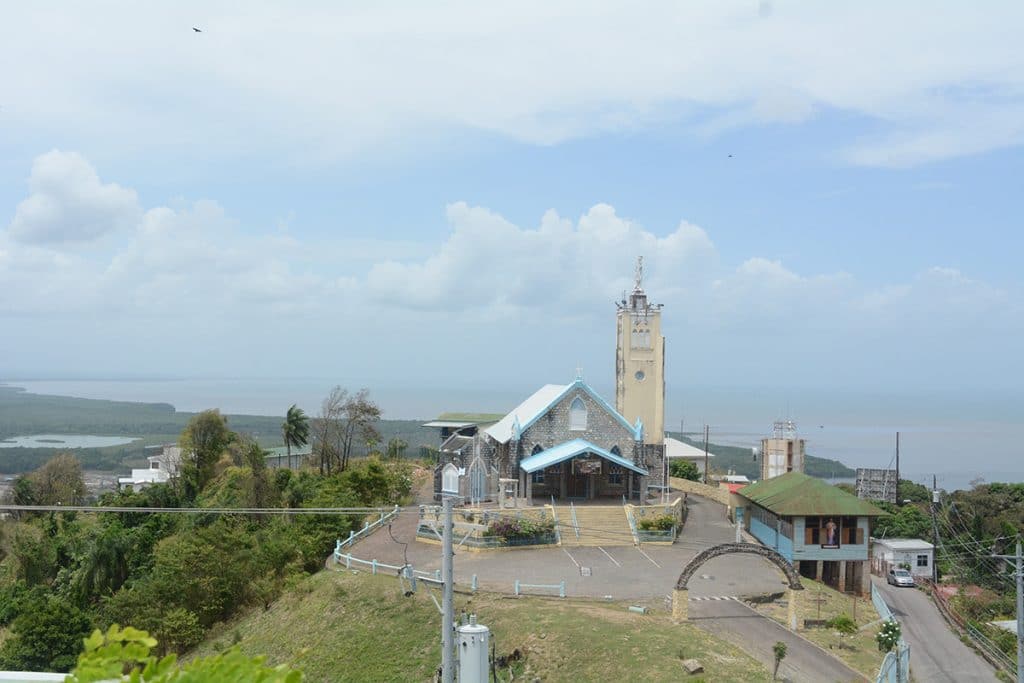By Leslie-Ann Paul
From the Hills of Laventille, Our Lady of Fatima has stood watch over the capital city and the communities within her radial view. Everyday braced by the sun when in the east, she returns the favour guiding its westerly sojourn. She is a landmark icon, and like the points of a compass, she gives direction to those entering and exiting the city. On the 9th of September in the year 2020, her watch was interrupted when a stroke of lightning removed her crown. This was the second occasion in history where she was struck by lightning. The first was in 1940. To address the wound, she would take temporary leave of her post until her structure was replaced in 1947.
The original 30ft statue arrived in Trinidad in 1878, a gift to the then Archbishop Mgr. Gonin O.P., from France. The old chapel, originally dedicated to St. Thomas Aquinas, was situated on hollow land, and could not accommodate the enormous statue. The Church therefore approached a nearby resident, Ms Marie Benjamin, to purchase a parcel of her land to establish a new chapel. After fruitful negotiations, construction of the chapel made of timber, including a 24ft belfry, was initiated on May 19, 1879, by two Dominican lay brothers. Unluckily, the construction was fraught with issues including flooding from torrential rains, and on the night of June 27, the Chapel and belfry came down. Despite the setback, construction of a stone church began in 1886. A new belfry, which still stands today, was also built at that time. The chapel’s cornerstone was laid by Princess Aldegonda of the House of Braganca, Portugal and her French husband Henri de Bourbon-Parma, Count of Bardi during their visit to Trinidad that year, and the building was completed in 1891.
Due to the presence of Our Lady, the hilltop chapel has had a strong Portuguese connection over the years. As early as 1885, there are reports of the Portuguese community making its pilgrimage to Laventille to commemorate the Feast of Nossa Senhora do Monte (Our Lady of the Mount, the patron saint of Madeira) on the 15th of August, sparing no expense to host celebrations. The Portuguese had arrived in Trinidad in waves from 1846 and had brought with them this custom.
A series of occurrences in Madeira in 1917 further cemented the Portuguese nexus to the Laventille chapel. Before three shepherd children, Marian apparitions were said to have appeared at the Cova da Iria in Fátima, Portugal. The first vision occurred on May 13th. As told by the oldest girl, Lucia, many years after the event, The Virgin Mary appeared “dressed in white, shining brighter than the sun, giving out rays of clear and intense light.” Mary would appear several more times (on the 13th day of subsequent months till October) to the children who were, thereafter, accompanied by curious villagers, none of whom experienced the sightings. But it was her final appearance which is most remembered. One account estimated that 70,000 people had journeyed to Fátima anticipating a miracle. Again, when the apparition appeared, it was seen only by the children. However, some present claimed to have seen the sun move in irregular directions or alleged that the sky assumed strange colours convincing them that a “sun miracle” occurred.
In Portugal, as in many other parts of the world where the Portuguese have settled, annual commemorations of this miracle sighting take place. In Trinidad, this occurs from May to October. As recently as the early 1990s, pilgrims of all ethnic backgrounds trekked on foot from the bottom of the hill to the Laventille church for the annual remembrance. Today, believers make their way in vehicles. Our Lady of Fatima continues to be recognised and adored by adherents of the Roman Catholic faith and her presence witnessed by all who look towards the Laventille hills.
The Marian shrine at Our Lady of Fatima is on the National Trust of Trinidad and Tobago’s Heritage Asset Inventory, underscoring its significance as a historical and architectural landmark. Following the incident, a joint team comprising members of the National Trust and heritage experts from Citizens For Conservation visited the shrine to assess the damage to the statue. We are currently working with the Archdiocese to determine the way forward. We are sure that the statue of Our Lady will soon grace the Belfry and the Hills of Laventille again.
References:
- Arcement, Katherine. “Our Lady of Fatima: The Virgin Mary promised three kids a miracle that 70,000 gathered to see.” The Washington Post. Oct. 13, 2017. <https://www.washingtonpost.com/news/retropolis/wp/2017/10/13/our-lady-of-fatima-the-virgin-mary-promised-three-kids-a-miracle-that-70000-gathered-to-see/>
- De Verteuil, Anthony. Temples of Trinidad. The Litho Press, Port of Spain, Trinidad. 2004.
- Pereira, John Jo-Anne S. Ferreira “The Contribution of the Portuguese to the Roman Catholic Church in Trinidad and Tobago.” The Portuguese of Trinidad and Tobago. 2011 <https://www.ttportuguese.com/the-contribution-of-the-portuguese>
- Radford, Benjamin. “The Lady of Fátima & the Miracle of the Sun” Live Science Contributor. May 02, 2013. <https://www.livescience.com/29290-fatima-miracle.html#:~:text=The%20story%20of%20a%20famous,tending%20a%20flock%20of%20sheep.&text=It%20was%20Mary%27s%20final%20appearance,that%20became%20the%20most%20famous.>




